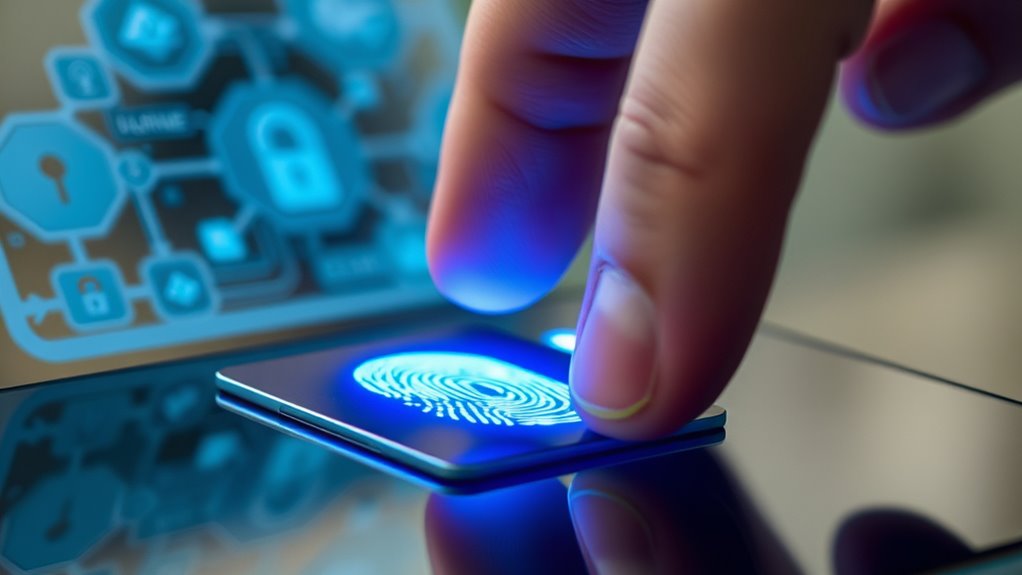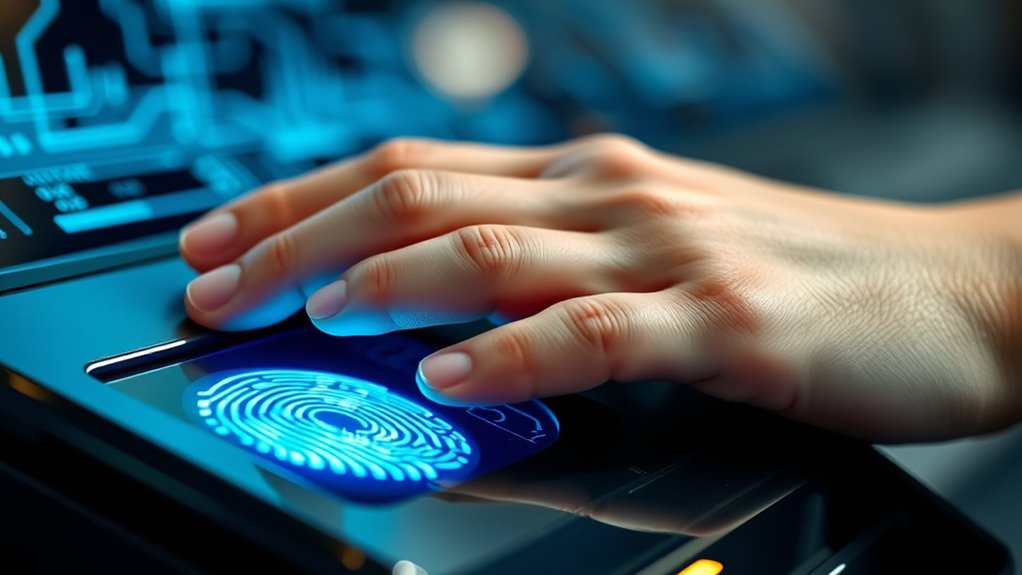Biometric authentication uses your unique physical or behavioral traits, like facial features or fingerprints, to verify your identity quickly and securely. It captures detailed maps of these features and compares them to stored data to grant access. This method offers a faster, more secure alternative to passwords while reducing the risk of unauthorized entry. As this technology advances, it aims to become even safer and easier to use. If you keep going, you’ll discover how it continues to improve and address privacy concerns.
Key Takeaways
- Biometric authentication verifies identity using unique physical or behavioral traits such as facial features and fingerprints.
- Facial recognition captures and compares facial feature maps for quick device unlocking and security checks.
- Fingerprint scanning reads ridge patterns to authenticate users, functioning effectively even with gloves or dirt.
- It offers enhanced security and user convenience while raising privacy concerns over data storage and protection.
- Ongoing advancements focus on faster, more secure systems while addressing vulnerabilities and safeguarding biometric data.

Have you ever wondered how your fingerprint or face can activate your phone? It’s fascinating how technology can identify you with such accuracy, making security both seamless and efficient. Biometric authentication uses unique physical or behavioral traits—like facial features or fingerprints—to verify your identity. Unlike traditional passwords or PINs, biometrics are difficult to duplicate, which means they offer a higher level of security. When you unlock your device with a fingerprint or face, you’re relying on sophisticated systems that analyze specific characteristics to guarantee it’s really you.
Facial recognition is one of the most popular biometric methods today. It works by capturing a detailed map of your face, including the distance between your eyes, nose shape, jawline, and other distinctive features. When you try to unlock your phone, the camera scans your face and compares the real-time image to stored data. If the match is close enough, access is granted instantly. This process is quick, often taking less than a second, and it’s designed to work in various lighting conditions. Facial recognition isn’t just used for unlocking phones; it’s also employed in security systems, airports, and banking apps, providing a convenient yet secure way to verify your identity.
Facial recognition quickly verifies your identity using detailed facial mapping in various security settings.
Fingerprint scanning, on the other hand, involves placing your finger on a sensor that reads the unique patterns of ridges and valleys on your fingertip. This technology has been around longer than facial recognition and is widely adopted because of its simplicity and reliability. When you set up fingerprint authentication, the sensor captures multiple images of your fingerprint from different angles. These images are then converted into a digital template stored securely on your device. Every time you scan your fingerprint to unlock your phone or authorize a transaction, the system compares the live scan to the stored template. If they match, you gain access. Fingerprint scanning is highly precise and works well even if you’re wearing gloves or your hands are slightly dirty.
Both facial recognition and fingerprint scanning have made digital security more user-friendly. They eliminate the need to remember complex passwords and reduce the risk of unauthorized access. However, they also raise privacy concerns, especially regarding how biometric data is stored and protected. That’s why most systems encrypt your biometric templates and store them locally on your device, rather than transmitting them over the internet. As biometric authentication continues to evolve, it promises even faster and more secure ways to safeguard your personal information while keeping the unlocking process effortless. Additionally, ongoing research into AI vulnerabilities highlights the importance of developing robust safety measures to protect biometric data from emerging threats.
Frequently Asked Questions
How Does Biometric Data Differ From Traditional Passwords?
Biometric data differs from traditional passwords because it relies on unique physical traits like fingerprints or facial features rather than something you memorize. You benefit from higher biometric accuracy, making it harder for others to impersonate you. Plus, your biometric data is protected through data encryption, ensuring it stays secure. Unlike passwords, which can be shared or stolen, biometric data offers a more secure and convenient way to verify your identity.
What Are Common Biometric Authentication Methods Used Today?
Think of biometric methods as your body’s unique signature. Today, you commonly use facial recognition, where your face becomes your password, and fingerprint scanning, which reads your fingerprint like a personal key. These methods offer quick, contactless access, making security both seamless and personal. As technology advances, these tools become more accurate, helping protect your data effortlessly while replacing traditional passwords that can be forgotten or stolen.
Can Biometric Data Be Stolen or Hacked?
Biometric data can be stolen or hacked, posing risks to your biometric data security. Hackers may use sophisticated methods to access and misuse your fingerprint, iris, or facial data. To prevent hacking, it is crucial to use strong security measures like encryption and multi-factor authentication. While biometric data is generally secure, staying vigilant and following best practices helps you protect your information and prevent unauthorized access.
How Is Privacy Protected in Biometric Systems?
You might wonder how privacy stays protected in biometric systems. To keep your data safe, these systems use data encryption, which makes your biometric information unreadable to unauthorized people. Additionally, they follow strict legal compliance standards to ensure your rights are preserved. This combination helps prevent hacking or misuse, giving you confidence that your biometric data remains private and secure while being used only for its intended purpose.
What Are Future Trends in Biometric Authentication Technology?
Future trends in biometric authentication are like a rising tide, transforming security landscapes. You’ll see more AI integration, making systems smarter and more adaptive, while multi-factor systems combine biometrics with other methods for enhanced protection. This evolution aims to balance convenience with security, reducing fraud and unauthorized access. As technology advances, you’ll find biometric authentication becoming seamless and more resilient, shaping the future of secure digital interactions.
Conclusion
Imagine opening your phone with a simple touch—biometric authentication makes that effortless. Just like a fingerprint uniquely identifies you, it provides a secure way to access your digital world. Over 1.4 billion biometric devices were in use in 2022, showing how trusted and widespread this technology has become. As you embrace this secure, seamless method, remember it’s like having a personal, uncopyable key—keeping your information safe while making life easier.









